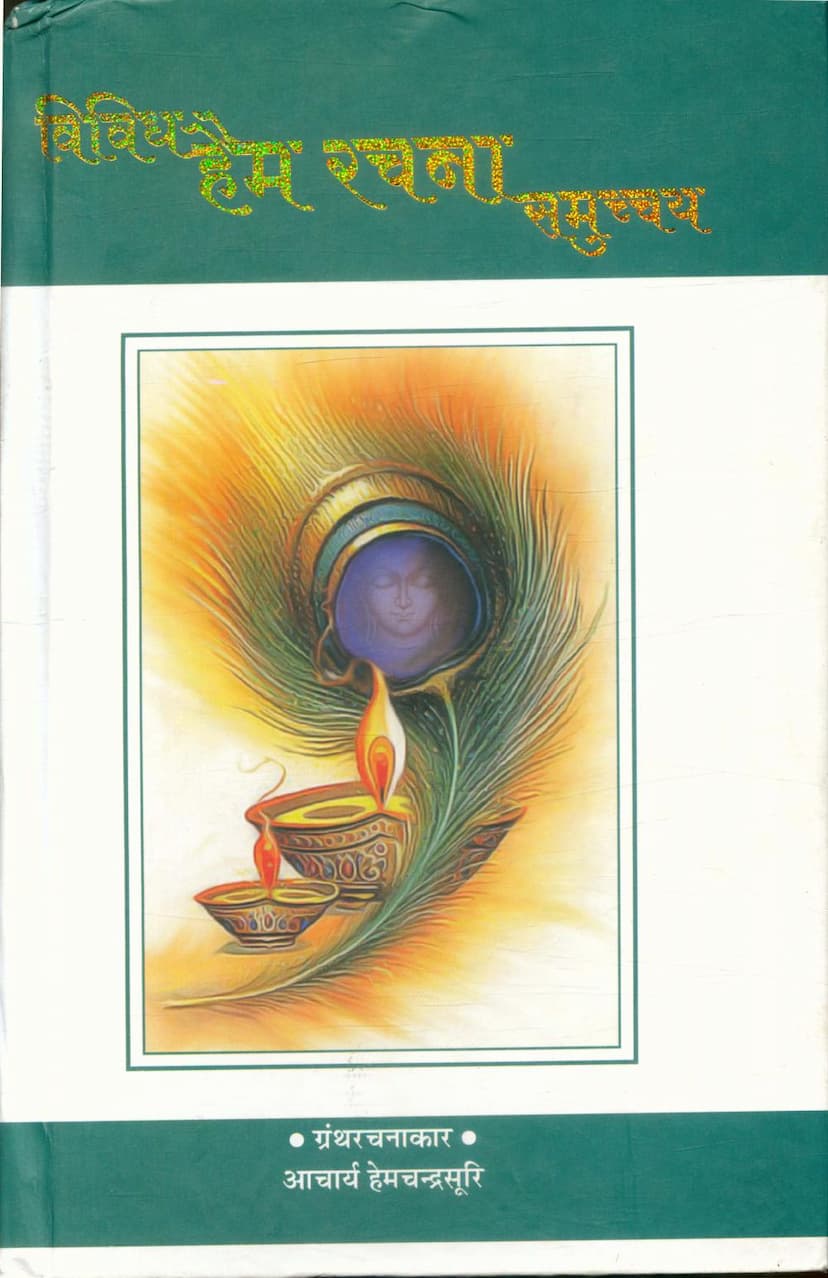Vividh Haim Rachna Samucchay
Added to library: September 2, 2025

Summary
Here's a comprehensive summary of the Jain text "Vividh Haim Rachna Samucchay" by Hemchandrasuri:
Book Title: Vividh Haim Rachna Samucchay (A Collection of Various Golden Compositions)
Author: Acharya Hemchandrasuri (also referred to as Muni Hemchandra)
Publisher: Shrutgyan Prasarak Sabha, Ahmedabad
Overall Nature of the Text:
This book is a compilation of various devotional, philosophical, and literary compositions in Sanskrit, primarily poetry (shlokas and verses), authored by Acharya Hemchandrasuri. The compositions are characterized by their deep devotion to Jain principles, philosophical insights, and skillful use of Sanskrit literary devices. The text serves as a testament to the author's extensive learning, spiritual inclination, and artistic talent.
Key Themes and Content:
The book is a collection of diverse compositions, covering a wide range of subjects related to Jainism. Based on the provided text, the following are the prominent themes and content areas:
- Praise of Jain Tirthankaras and Acharyas: A significant portion of the book is dedicated to the praise of Tirthankaras like Rishabhdev, Parshvanath, Mahavir Swami, and other revered figures in Jainism. It also includes eulogies for prominent Acharyas and spiritual leaders, highlighting their virtues, contributions, and spiritual prowess. For instance, there are stotras dedicated to Gautam Swami, Hari Bhadra Suri, Vijay Nemisurishwar, Vijay Amrut Surishwar, and Vijay Dev Suri.
- Devotional Hymns (Stotras and Ashtakams): The collection includes numerous devotional hymns, such as Ashtakams (eight-verse hymns) and Shodashikas (sixteen-verse hymns), dedicated to various deities and spiritual masters. These hymns express profound devotion, seek blessings, and expound on the glory of the divine.
- Philosophical and Ethical Reflections: The text delves into philosophical concepts, offering reflections on the nature of the soul, the pursuit of liberation (moksha), and ethical principles. The "Atma-bodh Panch-vishatika" and "Jivan Sad-vrutta-vinshatika" likely explore these themes.
- Praise of Jain Dharma and Its Principles: The compositions highlight the significance and efficacy of Jain Dharma, its principles like Ahimsa (non-violence), Satya (truth), Aparigraha (non-possessiveness), and Brahmacharya (celibacy). The "Shri Jinshasanashtakam" is a clear example of this.
- Narrative Poems: The book includes narrative compositions, such as the "Shri Jinas Vivasthikatha" and the epic poem "Shri Nemisaukhya Mahakavya" (excerpts of which are provided, detailing lineage and historical events), which narrate stories and events related to Jain history and figures.
- Praise of Sacred Places (Tirthas): Certain compositions focus on the glory and significance of important Jain pilgrimage sites, like Vimala-chala (Siddhachal), and Kadamba-giri, emphasizing the spiritual merit derived from visiting them.
- Praise of Spiritual Practices: The text also touches upon the importance of various spiritual practices like meditation, penance, and adherence to vows for spiritual advancement.
- Critique of Negative Tendencies: Some verses within the collection might subtly critique negative traits or philosophical deviations from the core Jain teachings, encouraging adherents towards righteous paths. The "Ashtadash Papsthana Kalochana Shatak" directly addresses the contemplation of eighteen negative conduct-related states.
- Literary and Linguistic Skill: Acharya Hemchandrasuri demonstrates mastery over Sanskrit grammar, poetic meters, and literary devices. The compositions are not only spiritually uplifting but also exhibit a high degree of literary artistry.
Author's Background and Journey:
The "Puravachan" (Foreword) by Acharya Hemchandrasuri himself provides valuable insights into his life and the genesis of his compositions. It highlights his early exposure to Jain philosophy and literature, his meticulous study under esteemed gurus, and the inspiration he received from spiritual mentors. He traces his journey from learning Sanskrit prose and poetry, his initial attempts at verse composition, and how significant events and personalities influenced his creative output. The foreword emphasizes the cooperative spirit and guidance received from his fellow monks and senior Acharyas, acknowledging their invaluable contribution to his literary endeavors. He also expresses gratitude to the anonymous patron whose financial support made the publication possible.
Key Figures Mentioned and Honored:
The text is replete with references and tributes to various revered Jain Acharyas and spiritual leaders. The introductory pages and various stotras prominently mention:
- Param Pujya Acharya Shri Vijay Nemisurishwarji Maharaja: Referred to as the "Shasan Samrat" and "Surichakra Chakravarti."
- Param Pujya Acharya Shri Vijay Amrut Surishwarji Maharaja: Described with epithets like "Piyushpani."
- Param Pujya Acharya Shri Vijay Dev Surishwarji Maharaja: Mentioned as "Param Saumya Murti" and the author's guru.
- Param Pujya Acharya Shri Vijay Meruprabh Surishwarji Maharaja: Recognized for his presence and guidance.
- Param Pujya Acharya Shri Vijay Dharamdhurdhar Surishwarji Maharaja: A respected spiritual leader.
- Acharya Shri Vijay Hemchandrasurishwarji Maharaja: The author himself, referred to as a "Samarth Vidwan" and a disciple of Acharya Shri Vijay Dev Surishwarji.
- Numerous other Acharyas and Munis are mentioned as influences, teachers, or fellow travelers on the spiritual path.
Structure and Publication:
The book is presented as a collection, with each composition having a specific title and often indicating the year of composition or the context. The publication is by Shrutgyan Prasarak Sabha, Ahmedabad, with a limited print run and specific points of contact for obtaining copies.
Overall Significance:
"Vividh Haim Rachna Samucchay" is a significant work that showcases the profound spiritual and literary contributions of Acharya Hemchandrasuri. It offers readers a rich repository of Jain devotional literature, philosophical discourse, and historical narratives, all presented with eloquence and artistic finesse in Sanskrit. The compilation reflects a deep reverence for Jain tradition, a commitment to spiritual knowledge, and a desire to share these valuable insights with future generations.